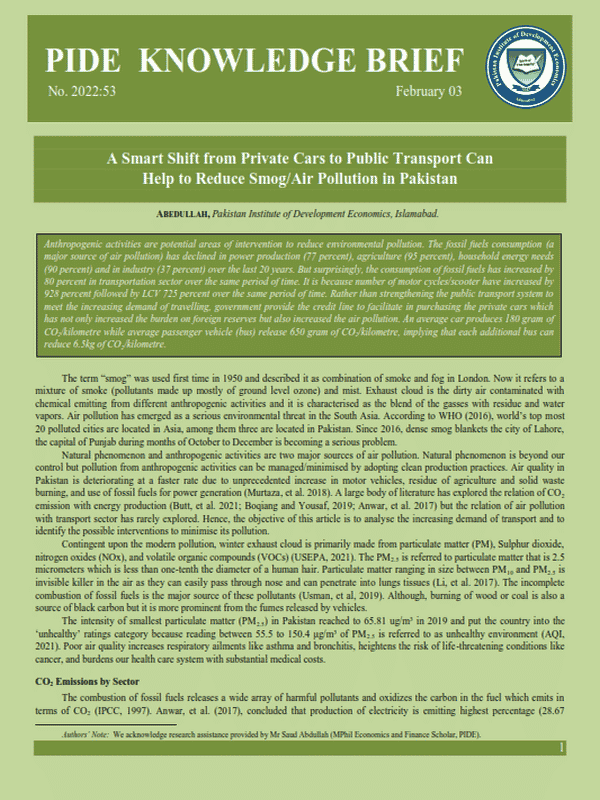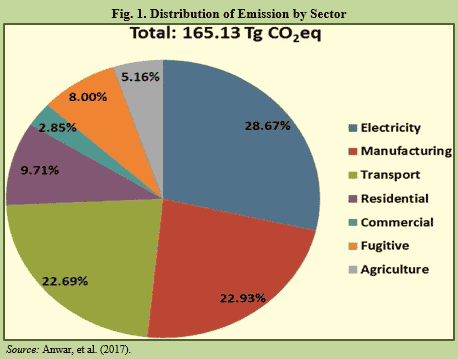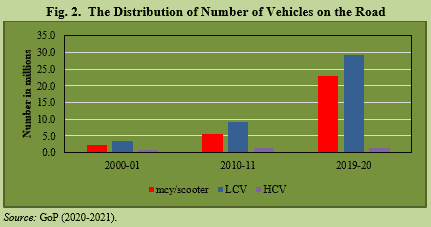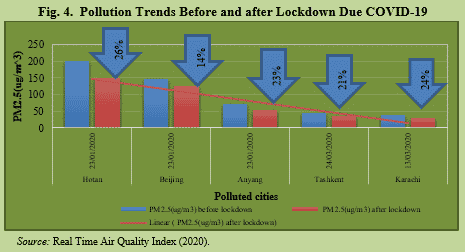
Pakistan Institute of Development Economics
- Home
Our Portals
MenuMenuMenuMenuMenuMenuMenu - ResearchMenuMenuMenuMenuMenuMenuMenu
- Discourse
- The PDR
- Our Researchers
- Academics
- Degree Verification
- Thesis Portal
- Our Portals
A Smart Shift from Private Cars to Public Transport Can Help to Reduce Smog/Air Pollution in Pakistan (PIDE Knowledge Brief No. 53:2022)
A Smart Shift from Private Cars to Public Transport Can Help to Reduce Smog/Air Pollution in Pakistan
Abedullah, Pakistan Institute of Development Economics, Islamabad.
| Anthropogenic activities are potential areas of intervention to reduce environmental pollution. The fossil fuels consumption (a major source of air pollution) has declined in power production (77 percent), agriculture (95 percent), household energy needs (90 percent) and in industry (37 percent) over the last 20 years. But surprisingly, the consumption of fossil fuels has increased by 80 percent in transportation sector over the same period of time. It is because number of motor cycles/scooter have increased by 928 percent followed by LCV 725 percent over the same period of time. Rather than strengthening the public transport system to meet the increasing demand of travelling, government provide the credit line to facilitate in purchasing the private cars which has not only increased the burden on foreign reserves but also increased the air pollution. An average car produces 180 gram of CO2/kilometre while average passenger vehicle (bus) release 650 gram of CO2/kilometre, implying that each additional bus can reduce 6.5kg of CO2/kilometre. |
The term “smog” was used first time in 1950 and described it as combination of smoke and fog in London. Now it refers to a mixture of smoke (pollutants made up mostly of ground level ozone) and mist. Exhaust cloud is the dirty air contaminated with chemical emitting from different anthropogenic activities and it is characterised as the blend of the gasses with residue and water vapors. Air pollution has emerged as a serious environmental threat in the South Asia. According to WHO (2016), world’s top most 20 polluted cities are located in Asia, among them three are located in Pakistan. Since 2016, dense smog blankets the city of Lahore, the capital of Punjab during months of October to December is becoming a serious problem.
Natural phenomenon and anthropogenic activities are two major sources of air pollution. Natural phenomenon is beyond our control but pollution from anthropogenic activities can be managed/minimised by adopting clean production practices. Air quality in Pakistan is deteriorating at a faster rate due to unprecedented increase in motor vehicles, residue of agriculture and solid waste burning, and use of fossil fuels for power generation (Murtaza, et al. 2018). A large body of literature has explored the relation of CO2 emission with energy production (Butt, et al. 2021; Boqiang and Yousaf, 2019; Anwar, et al. 2017) but the relation of air pollution with transport sector has rarely explored. Hence, the objective of this article is to analyse the increasing demand of transport and to identify the possible interventions to minimise its pollution.
Contingent upon the modern pollution, winter exhaust cloud is primarily made from particulate matter (PM), Sulphur dioxide, nitrogen oxides (NOx), and volatile organic compounds (VOCs) (USEPA, 2021). The PM2.5 is referred to particulate matter that is 2.5 micrometers which is less than one-tenth the diameter of a human hair. Particulate matter ranging in size between PM10 and PM2.5 is invisible killer in the air as they can easily pass through nose and can penetrate into lungs tissues (Li, et al. 2017). The incomplete combustion of fossil fuels is the major source of these pollutants (Usman, et al, 2019). Although, burning of wood or coal is also a source of black carbon but it is more prominent from the fumes released by vehicles.
The intensity of smallest particulate matter (PM2.5) in Pakistan reached to 65.81 ug/m³ in 2019 and put the country into the ‘unhealthy’ ratings category because reading between 55.5 to 150.4 μg/m³ of PM2.5 is referred to as unhealthy environment (AQI, 2021). Poor air quality increases respiratory ailments like asthma and bronchitis, heightens the risk of life-threatening conditions like cancer, and burdens our health care system with substantial medical costs.
_________________________
Authors’ Note: We acknowledge research assistance provided by Mr Saud Abdullah (MPhil Economics and Finance Scholar, PIDE).
CO2 Emissions by Sector
The combustion of fossil fuels releases a wide array of harmful pollutants and oxidizes the carbon in the fuel which emits in terms of CO2 (IPCC, 1997). Anwar, et al. (2017), concluded that production of electricity is emitting highest percentage (28.67 percent) of CO2, followed by industrial sector (22.93 percent) and transport sector (22.69 percent), implying that transport is the third largest contributor in the environment pollution (Figure 1). It is important to note that emissions from coal, oil, and natural gas activities are also considered in all sectors. A total amount of 149.73 Tg were emitted as CO2, 14.78 Tg CO2eq as CH4, and 0.62 Tg CO2eq as N2O (Anwar, et al. 2017).
Poor Public Transport Infrastructure and Demand for Cars
Rapid economic and population growth and social revolution soaring the demand for means of traveling. Developing economies like Pakistan fails to invest on public transport infrastructure to expand transport facilities to meet the increasing demand and public has no choice except to buy own cars for mobility, even though it is an expensive option. Thus, with the increase in population pressure, the demand for alternative mode of transport (Motor car, taxies, Devan, pickup, jeep, and station wagons) start to upsurge. The first metro-bus system was launched in 2013 in Lahore, followed by Rawalpindi-Islamabad in 2015. First orange line metro train in Pakistan was officially inaugurated on 20th October 2020 and it is expected to carry 250,000 passengers every day. But it is not sufficient to meet the increasing demand of mobility in mega cities of Pakistan and therefore, number of cars are continuously increasing.
We have divided all type of vehicles used in Pakistan into three categories, i.e mcy/scooter (bike), light commercial vehicles (LCV),[1] and heavy commercial vehicles (HCV)[2]. The number of vehicles of different types has increased in the range of 928 percent (motor cycles/scooter) in 2000-01 to 64 percent in heavy commercial vehicle (HCV) in (2019-20), implying that government failed to provide a successful transport system independently or with the collaboration of private sector to accommodate the increasing population pressure (Figure 2). This lead to increase the gap between demand and supply. Hence, people has no choice except to purchase their own transport to commute from one place to another place. The highest increase is observed in case of bikes followed by LCV (725 percent) during the last 20 years. Bike and LCV is owned by the people belongs to middle and high income group, respectively. The increase in HCV remained comparatively low because neither government take the responsibility to fill the increasing demand of travelling by publicly owned buses or train nor with the collaboration of private sector. In addition to this, government also fails to provide sufficient infrastructure to attract the investment of private sector (local or foreign). However, government facilitate the high income group by providing credit line to buy privately owned vehicle or to improve the rented car facilities by ignoring its impact on the environment. The drastic increase in number of bikes and cars over the last two decades has not only lead to increase the environmental pollution over time due to increasing combustion of fossil fuels (Figure 3) but expansion of roads to facilitate these additional vehicles also occupied the land of pedestrians and cyclists.
__________________________
[1] LCV contains motor car, motor cab/taxi, D. van, pickup, station wagon, Jeep and motor rickshaw.
[2] HCV contains ambulance, buses, trucks, tractor, oil and water tanker and others.
The average car that uses petrol produces an CO2 equivalent of 180 gram/kilometre while average passenger vehicle (bus) release CO2 equivalent of 650 gram/kilometre (BBC future, 2020). This implies that if in each car 4 persons are riding which is rare in Pakistan. Hence, under the assumption if two persons are travelling in a car, then one bus with 80-100 passengers can replace about 40 cars while each bus is polluting equal to 3.6 cars only. This implies that a bus can reduce CO2 equivalent of 6.5kg/kilometre. Hence, in our car dominated cities a large potential exists to cut down the carbon footprints in our daily commute. Further, it is estimated that one car takes the space of about 100 pedestrians when you consider the space to facilities that must be kept free in front and back. In that space 15–20 bicycles can be operated. A bus with about 80–100 passengers takes the space of about 3 cars only while it can replace about 25-30 cars. Most major cities of world have begun to price the use of cars to curtail its use (Haque, 2019) but it is not getting popular in Pakistan yet. The policy of car parking fee may help to limit the use of cars in Pakistan under the condition that alternative options are made available to commute from one place to another place.
Fossil Fuel Consumption
The consumption of fossil fuels in power production (electricity) has declined from 6.5 million tons in 2000-01 to 1.5 million tons in 2019-20, indicating a 77 percent decline over the last 20 years. The similar declining trend of fossil fuel consumption is observed at the household level (90 percent), agriculture (95 percent) and industry (37 percent), demonstrating that anthropogenic activities are deploying cleaner sources of energy except power plants where use of coal has increased over time. In contrast, the use of fossil fuels has dramatically increased about 80 percent (from 8.2 million tons to 14.7 million tons) in transport industry over the last twenty years (Figure 3). This is an alarming situation for the environment and thus, policy measures need to put in place to revert the increasing trend of fossil fuel use in the transportation sector.
Environment Scenario of Post COVID-19
The COVID-19 lockdown that have irked billions and economic activities were grind to a halt appeared as a sort of blessing for the environment as people spend less time in vehicles, offices, factories and more bounded to home. As economic activities slowdown in all major polluted cities of the world, these cities have recorded unprecedented fall in air pollution. A comparison in five worst polluted cities of the world (Hotan, Beijing, Anyang, Tashkent and Karachi) indicates a downward trend in air pollution Figure (4).
The above graph shows fall in air pollution as the single greatest positive effect of Lock down on environment using PM2.5 (ug/ ) concentration data over 40 days before and after lockdown. The government of republic of China enforced the nation into strict lockdown on 23rd January 2019 and Anyang, Beijing and Hotan cities have experienced decline in PM2.5 (ug/ ) concentration by 26 percent, 14 percent and 23 percent in the early 20 days of lockdown. Because Chinese government have introduced new rules of car use by allowing the vehicles on alternate day depending on their number plates which has contributed toward reduction in air pollution level.
The Karachi city also have shown dramatic decline of 24 percent in PM2.5 (ug/ ) concentration, once the government imposed stringent lockdown on 13th march, 2020. Due to significant decline in air pollution, the Karachi city has been placed among the moderate polluters as its particulate matter concentration fall in the range of 12.1- 35.4 ug/ after lockdown. The National Forum for Environment and Health (NFEH) reported that with minimum public and private transport on the roads and limited industrial activity, Karachi’s air pollution problem had been eased for the time being. All these evidence supports that transportation is one of the major factor contributing towards environmental pollution. Only improved public transport facilities with the extended network can help to minimise the use of private cars.
REFERENCES
Anwar K. M., Purohit P., & Mehmood, S. (2017). Sectoral assessment of greenhouse gas emissions in Pakistan. Environmental Science and Pollution Research. 24, 27345–27355.
AQI (2021). Air quality index in Pakistan. https://www.iqair.com/pakistan
BBC future (2020). Smart guide to climate change. https://www.bbc.com/future/article/20200317-climate-change-cut-carbon-emissions-from-your-commute
Boqiang, L. & Yousaf, R. M. (2019). Analysis of energy related CO2 emissions in Pakistan. Journal of Cleaner Production. 219. doi: 10.1016/j.jclepro.2019.02.112
Butt, D., Lauri, M., & Dahiya, S. (2021). CO2 emissions from pakistan’s energy sector. Centre for Research on Energy and Clean Air.
GoP (2020-2021). Economic survey of Pakistan. Islamabad: Government of Pakistan, Finance Division.
Haque, N. U. (2019). Why are we subsidising car-use. (PIDE blog Series).
IPCC (1997). In Houghton, J. T., Meira Filho, L. G., Lim, B., Treanton, K., Mamaty, I., Bonduki, Y., Griggs, D. J., & Callander, B. A. (eds.) Revised 1996 IPCC guidelines for national greenhouse gas inventories. Intergovernmental Panel on Climate Change (IPCC), Meteorological Office, Bracknell.
Li, R., Cui, L., & Li, J. et al. (2017). Spatial and temporal variation of particulate matter and gaseous pollutants in China during 2014–2016, Atmospheric Environment 161, 235–246.
Murtaza R., Khokhar, M. F., Zeb, N., Noreen, A. & Hakeem, K. R. (2018). Multi-sensor temporal assessment of tropospheric nitrogen dioxide column densities over Pakistan, Environ Sci Pollut Res, https://doi.org/10.1007/s11356-017-1176-7, 2018
Real Time Air Quality Index (2020). https://waqi.info/
USEPA (2021). US environmental protection agency. https://www.epa.gov/transportation-air-pollution-and-climate-change/smog-soot-and-local-air-pollution
Usman, M., Aamir, H. M., Naz, Iqbal H. F., & Arshad, H. A. (2019). New techniques for the prevention control of smog and air pollution in Pakistan. Environ Pollut Climate Change 2, 166. DOI: 10.4172/2573-458X.1000166
WHO–World Health Organisation Report (2016). Ambient (outdoor) air pollution in cities database 2016. Published on 27th Sep 2016 Press Release, https://www.who.int/airpollution/data/cities-2016/en/ Last Access: 27 Oct 2018.







